Giraffes! These magnificent creatures have always fascinated humans with their incredible height and unique appearance. In this blog post, we will dive into the fascinating world of giraffes and explore their history, facts, size, habitat, and classification.
Giraffes belong to the animal kingdom and are a part of the animal group called mammals. They are one of the most beloved animals in the world due to their long necks and beautiful spots. These gentle giants have a rich history that dates back millions of years. Did you know that giraffes are descendants of ancient animals called okapi? It’s incredible how these gentle creatures have evolved!
Let’s move on to some interesting facts about giraffes. Did you know that giraffes are the tallest land animals on Earth? They can grow up to a staggering height of 18 feet! These gentle giants have long necks and elongated legs that help them search for food in tall trees. Regarding food, giraffes are herbivores, meaning they only eat plants and leaves. Their favourite meal is the delicious leaves found high up in the trees.
Now, let’s talk about where giraffes live. They can be found in the grasslands, savannas, and open woodlands of Africa. These habitats provide the necessary food and shelter for these fantastic creatures. Giraffes live in herds with other members of their species, making them social animals. They communicate using vocalizations, head movements, and tail flicks.
History of Giraffe
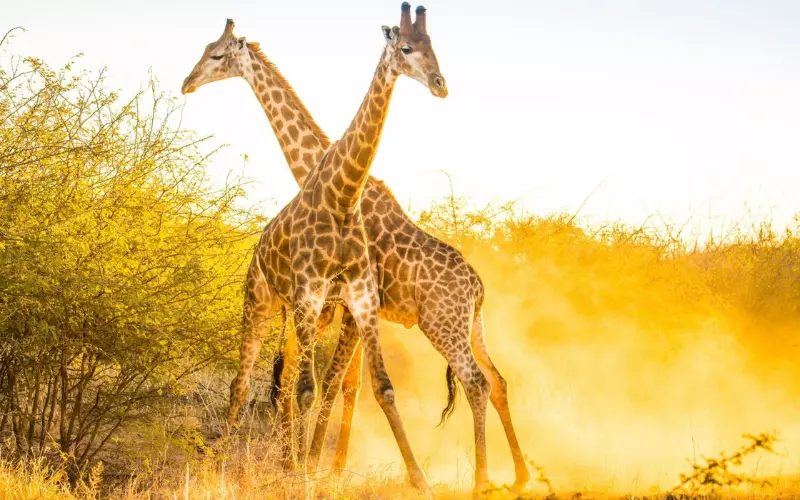
Giraffes are fascinating creatures that have captured the curiosity of humans for centuries. These majestic animals are known for their incredibly long necks, unique spotted coats, and graceful movements. The history of giraffes dates back thousands of years, with their origins rooted in Africa.
For many years, giraffes were a mystery to people outside of Africa. It wasn’t until the 18th century that they were recognized as a separate species. European explorers and scientists marvelled at these extraordinary animals and brought back tales of their remarkable features. Their distinct appearance and behaviour made them a subject of great interest and wonder.
Giraffes have been a part of African culture and folklore for centuries. In ancient Egypt, they were considered a symbol of grace and beauty. The ancient Romans even held giraffe races in their colosseums, showcasing these creatures to amaze spectators. As time passed, giraffes were brought to zoos and menageries worldwide, allowing people from different cultures to see and learn about them firsthand.
Today, giraffes face various challenges, including habitat loss and poaching. Conservation efforts are in place to protect these remarkable animals and ensure their survival for future generations. By studying their history and understanding their unique traits, we can appreciate and work towards preserving the incredible legacy of giraffes.
Importance of Giraffe
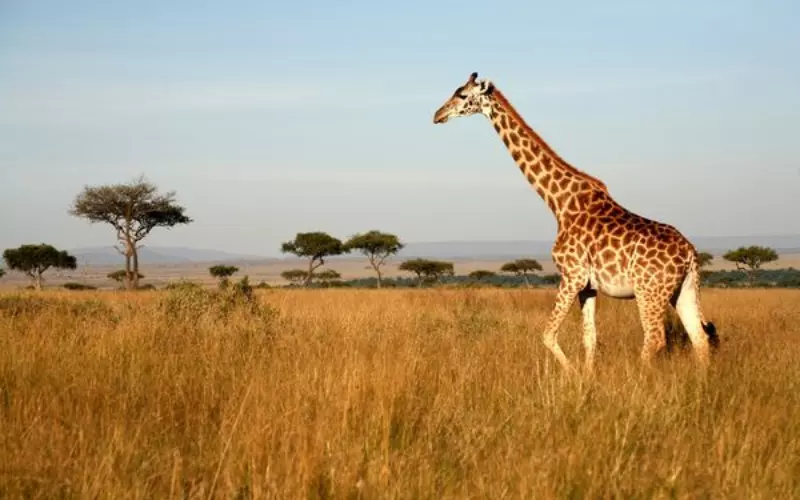
Giraffes are magnificent animals that we can find in some parts of Africa. They are known for their exceptionally long necks, which help them reach food that other animals cannot. The giraffe’s neck can grow up to six feet long, allowing them to eat leaves from tall trees. This is important because it helps maintain the balance of the ecosystem.
Giraffes play a crucial role in spreading seeds from trees. Some seeds pass through their digestive system when they eat the leaves and are later excreted as they travel around. These seeds then grow into new trees, contributing to the diversity and growth of the forest. Without giraffes, this process would be interrupted, and many tree species could struggle to reproduce effectively.
Furthermore, giraffes are a symbol of nature’s beauty. People from all around the world come to Africa to see and admire these magnificent creatures. Tourism related to giraffes brings economic benefits to the local communities, supporting jobs and businesses in the area.
Giraffes are unique and vital animals. They help maintain the balance of the ecosystem by spreading seeds from trees, and they contribute to local economies through tourism. By understanding the importance of giraffes, we can appreciate and protect these incredible creatures, ensuring their survival for generations to come.
Amazing Facts About Giraffes

1. Giraffes are the tallest land animals on Earth; adult males can reach around 16 to 18 feet.
2. These magnificent creatures have long necks that can measure up to 6 feet in length, allowing them to browse leaves from tall trees.
3. A giraffe’s tongue is black and can be up to 20 inches long, which helps them grasp and eat leaves from thorny trees.
4. Despite their long necks, giraffes have the same number of neck vertebrae as humans, which is 7.
5. One exciting fact about giraffes is that their spots are unique, like human fingerprints.
6. These beautiful animals have vast and expressive eyes that help them spot predators from afar.
7. Giraffes are herbivores, which means they eat only plants. They mainly feed on leaves, buds, and shoots from different tree species.
8. Due to their diet, giraffes can spend hours grazing and consuming large amounts of foliage each day.
9. Giraffes have a prehensile upper lip, meaning they can use it to grab onto branches and pull leaves off trees.
10. They have powerful kicks that can be fatal for potential predators, such as lions, hyenas, and crocodiles.
11. Despite their weight of around 1,800 kilograms, giraffes can run up to 35 miles per hour for short distances.
12. They are social animals that usually form small groups called herds led by an adult male called a bull.
13. Female giraffes give birth while standing, and their calves fall around five feet to the ground when they are born.
14. Newborn giraffes are incredibly tall, measuring about 6 feet at birth, and they can start walking within an hour after birth.
15. Giraffes have a lifespan of about 25 years in the wild but can live longer, up to 30 years, in captivity.
Can we keep a Giraffe as our Pet?
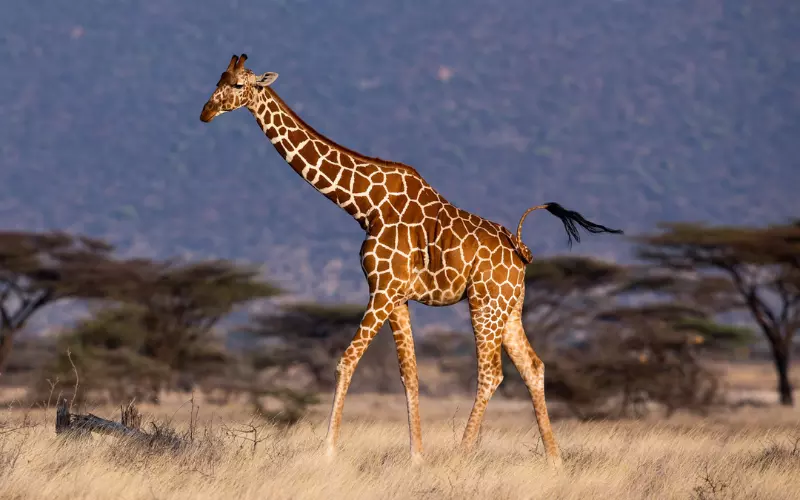
Giraffes are magnificent creatures that roam the savannas of Africa. However, keeping a giraffe as a pet is not practical or feasible. Giraffes are wild animals that require a specific habitat, ample space to move around, and a specialized diet to thrive. Meeting these needs in a domestic setting would be highly challenging.
Firstly, giraffes are known for their incredible height, reaching 19 feet. They need a large enclosure to live comfortably and move freely. A typical home cannot accommodate their size. Giraffes also have specific dietary requirements. They mainly eat leaves and buds from tall trees, such as acacia trees, which are not readily available in most areas. Providing a suitable diet would be a significant challenge for any pet owner.
Moreover, giraffes are social animals that thrive in herds. Isolating a giraffe from its natural habitat and companionship could lead to severe physical and psychological problems. They are adapted to living in the wild, where they can roam vast distances and interact with other animals.
While giraffes are fascinating creatures, they are not suitable to keep as pets. Their size, dietary needs, and social nature make it difficult to provide a proper environment for them in a domestic setting. Giraffes should be admired from a distance, in their natural habitat, where they can live their lives to the fullest.
Size of Giraffe
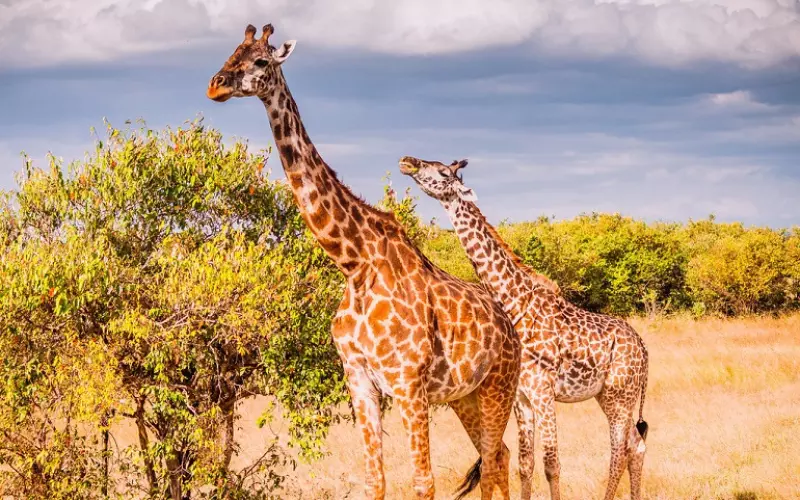
Giraffes are truly remarkable animals, known for their stunning size. These majestic creatures are known to be the tallest mammals on Earth. Can you believe that an adult giraffe can reach up to 18 feet? That’s taller than most double-decker buses! Their long necks alone can measure around 6 feet, taller than most adults.
Not only are giraffes tall, but they’re also quite massive. An adult male giraffe can weigh up to 3,000 pounds, similar to a small car’s weight! Female giraffes are usually more miniature, weighing around 1,600 to 2,600 pounds. Their bodies are pretty slender and have long, powerful legs that allow them to run at incredible speeds. Giraffes are known for their unique spotted pattern, which helps them blend in with their surroundings and stay safe from predators.
Even as newborns, giraffes are already giant compared to many other animals. A baby giraffe, or calf, comes into this world standing at an impressive 6 feet tall. That’s taller than most adults. Calves grow incredibly fast and can gain about an inch in height daily during their first week of life. This rapid growth allows them to reach adulthood in just a few years.
Giraffes are remarkably tall and massive animals. From their towering height to their elegant spotted appearance, these incredible creatures continue to captivate our imagination. Whether as adults or newborns, giraffes are genuinely unique in size and leave us in awe of their grandeur.
Habitat of Giraffe

The giraffe lives in a fantastic place called its habitat. This is where it eats, sleeps, and spends most of its time. The habitat of a giraffe is the African savanna, a vast land filled with tall grasses, shrubs, and trees. This place is perfect for giraffes because they can find plenty of tasty leaves to munch on!
In the African savanna, giraffes can roam freely and find food without trouble. They can reach the leaves on trees that other animals can’t because they have long necks. Giraffes love to eat the leaves of acacia trees, which are found in their habitat. These tall trees allow giraffes to use their long necks to reach their favourite food.
Giraffes also have another excellent adaptation that helps them survive in their habitat. Their long legs help them run fast. This is important because, in the savanna, there are dangerous animals, like lions and hyenas, that would love to make a meal out of a giraffe! Their long legs enable them to run away quickly and escape danger.
The habitat of a giraffe is the African savanna, full of tall grasses, shrubs, and trees. Giraffes love to eat the leaves of acacia trees, and their long necks and legs help them survive in this habitat. They can reach the leaves other animals can’t and run fast to escape predators.
Classification of Giraffe
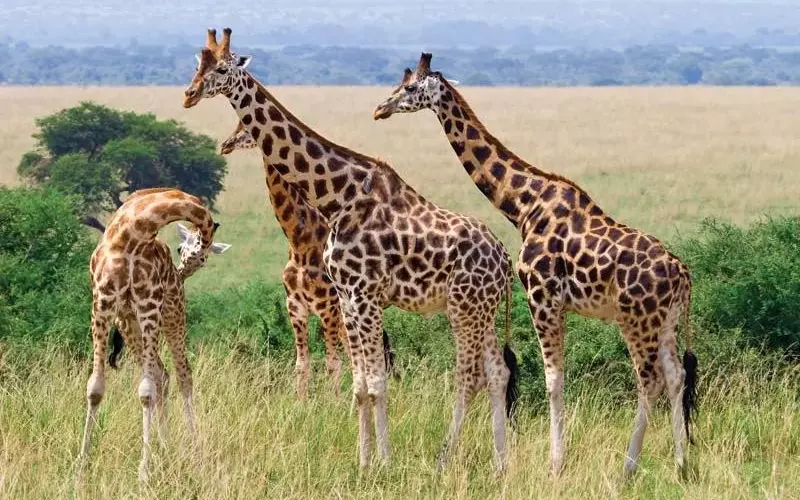
The giraffe is a fascinating animal that belongs to the classification of mammals. It is a herbivore, which means it feeds only on plants. Giraffes are native to Africa and known for their long necks and unique patterned coats. They are the tallest land animals, with males reaching heights up to 18 feet!
Giraffes belong to the family Giraffidae and the genus Giraffa. There are nine known sub-species of giraffes, including the Northern giraffe, Southern giraffe, and Masai giraffe. Each sub-species has distinct physical characteristics and can be found in different regions of Africa. Despite their differences, all giraffes share similar features, such as their long necks, legs, and ossicones – those horn-like structures on top of their heads.
Giraffes are part of the order Artiodactyla, which includes creatures like antelopes and deer. They are also part of the class Mammalia, which includes animals that have fur or hair, give birth to live young, and nurse them with milk. Giraffes have a four-chambered stomach, which helps them digest the tough leaves and twigs they eat. Like humans, they have a heart, lungs, brain, and other vital organs.
The giraffe is an interesting animal that belongs to the classification of mammals. It is a herbivore and the tallest land animal on Earth. Giraffes have different sub-species and are part of the family Giraffidae, the genus Giraffa, the order Artiodactyla, and the class Mammalia. They have unique features like long necks and ossicones, allowing them to adapt and survive in their natural habitat.
Different Types of Giraffe
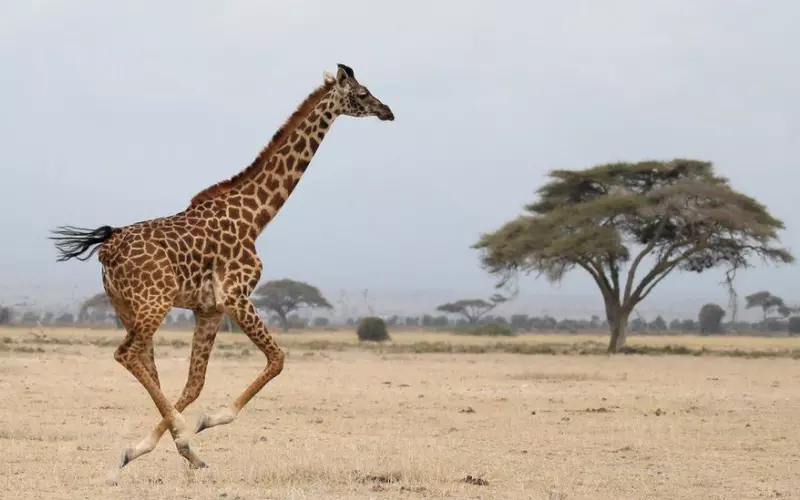
1. Masai Giraffe: The tallest of all giraffe species, the Masai giraffe can reach heights of up to 18 feet! They have unique dark patches and a long neck, which helps them to reach leaves high in the trees.
2. Reticulated Giraffe: This giraffe has a distinctive, interconnected pattern of white lines on a reddish background. Their pattern helps them blend into their surroundings, making hiding from predators such as lions easier.
3. Rothschild’s Giraffe: Recognized by their beautiful coat, Rothschild’s giraffes have large, dark spots that almost appear rectangular. They are an endangered species, and their population has declined due to habitat loss and poaching.
4. South African Giraffe: Also known as the Southern giraffe, this type can be found in southern Africa. They have a lighter coat with patches that range from orange-brown to dark brown. Their long necks allow them to easily browse for leaves, even in trees with thorns.
5. Thornicroft’s Giraffe: Named after the national park in Zambia, where they are found, Thornicroft’s giraffes have a unique coat pattern with small, irregular spots. They are smaller than other species and have adapted to the park’s woodland and savannah habitats.
6. West African Giraffe: This giraffe species once faced extinction but has remarkably recovered. They have a lighter-coloured coat with patches that are more jagged and vine-shaped. Their population is still small and limited to parts of Niger and Mali.
7. Nubian Giraffe: Found in Ethiopia and South Sudan, the Nubian giraffe has a pale coat with large, irregularly shaped spots. They are considered vulnerable due to habitat loss and conflict in their native regions.
8. Angolan Giraffe: Living in the sandy landscapes of Namibia, Botswana, and Angola, Angolan giraffes have a coat with medium-sized spots. They graze on various plants, such as acacia trees, and their long legs help them quickly move through the desert terrain.
9. Kordofan Giraffe: Native to West Africa, Kordofan giraffes have a reddish-brown coat with large, block-shaped spots. They have adapted to live in both dry woodland and savannah environments.
10. Thornberry’s Giraffe: This giraffe species, also called the Maasai giraffe, has a pattern of jagged-edged patches on a light coat, similar to the Rothschild’s giraffe. They are found in parts of eastern and southern Africa and are easily recognized by their long legs and necks.
Geographical Presence of Giraffe
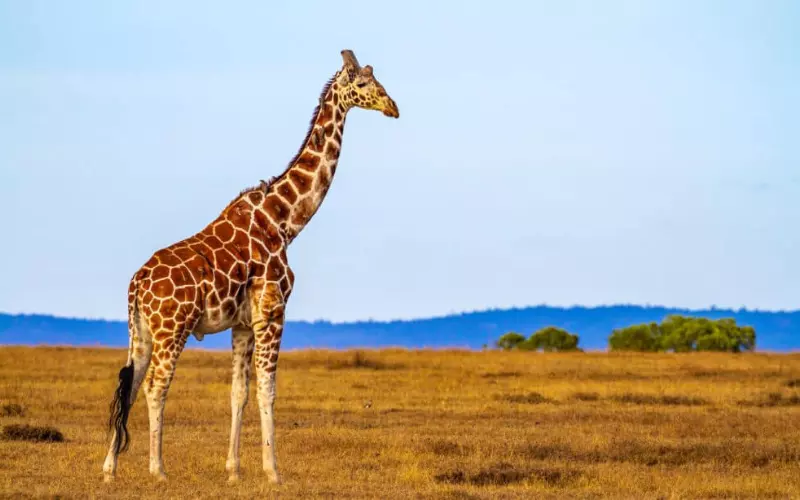
The giraffe is found in the continent of Africa, specifically in the sub-Saharan region. This means that giraffes are native to Kenya, Tanzania, South Africa, and others in this part of Africa. Giraffes have adapted to various habitats, including grasslands, savannas, and open woodlands. They are well-suited to these environments due to their long necks, which help them reach high branches for food, and their strong legs, which allow them to travel long distances.
However, giraffes are not found outside of Africa in other parts of the world. They do not live in places such as Europe, Asia, or the Americas. This is because giraffes are endemic to Africa, which means they are naturally found only in this region. Africa’s specific climate, vegetation, and ecosystem provide the ideal conditions for giraffes to survive and thrive.
Unfortunately, the giraffe population has been declining in recent years due to habitat loss and poaching. Efforts are being made to protect these magnificent creatures and ensure their survival. Conservation organizations and governments are implementing measures such as creating protected areas, enforcing anti-poaching laws, and raising awareness about preserving giraffes and their habitats.
Giraffes are found in the sub-Saharan region of Africa and are not naturally found in other parts of the world. They have adapted to various habitats within this region and are well-suited to the African climate and ecosystems. Efforts are being made to protect giraffes and their habitats to ensure their survival for future generations.
Diet of Giraffes
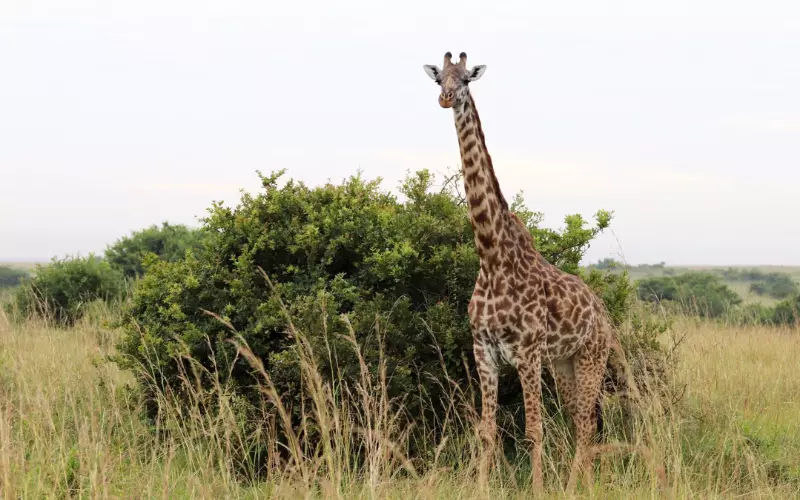
Giraffes have a unique and exciting diet mainly composed of leaves from tall trees. These magnificent creatures are herbivores, which means they only eat plants and do not hunt or eat other animals. Leaves make up about 75% of their diet!
The long neck of a giraffe allows it to reach high branches that other animals can’t access. They prefer to munch on the acacia tree leaves, their favourite food. Giraffes have specially designed tongues and lips that help them grasp and pull leaves off the trees. They use their long tongues, up to 18 inches (46 cm) long, to strip the leaves from the branches carefully.
Giraffes eat a lot because they need enough leaf nutrients to survive. Interestingly, they spend most of their day eating, around 16 to 20 hours! Due to the leafy diet, giraffes get essential nutrients like calcium, protein, and vitamins. They also obtain water from the leaves they consume, which helps them stay hydrated in the dry savannah.
Giraffes have a unique and specialized diet consisting mainly of tall tree leaves. With their long necks and tongues, they can reach high branches and strip the leaves to eat. This leafy diet provides them essential nutrients and water to survive in their natural habitat. Giraffes are truly fascinating creatures in the animal kingdom!
Locomotion of Giraffe’s

The way a giraffe moves around is quite stunning! Its long legs give it a unique style of locomotion. When a giraffe walks, it simultaneously moves both legs on one side of its body. This means that the right front leg and the right back leg step forward together, followed by the left front leg and the left back leg. It gives the giraffe a smooth and graceful walk.
But that’s not all! When a giraffe wants to run, it can reach incredible speeds. It uses its front and back legs simultaneously, like when it walks, but now it stretches them out more. This allows it to cover a lot of ground with each stride. So even though giraffes look a bit clumsy, they are skilled at moving around, whether walking with elegance or running fast to escape from danger.
Social and Sexual Behaviour of Giraffe’s
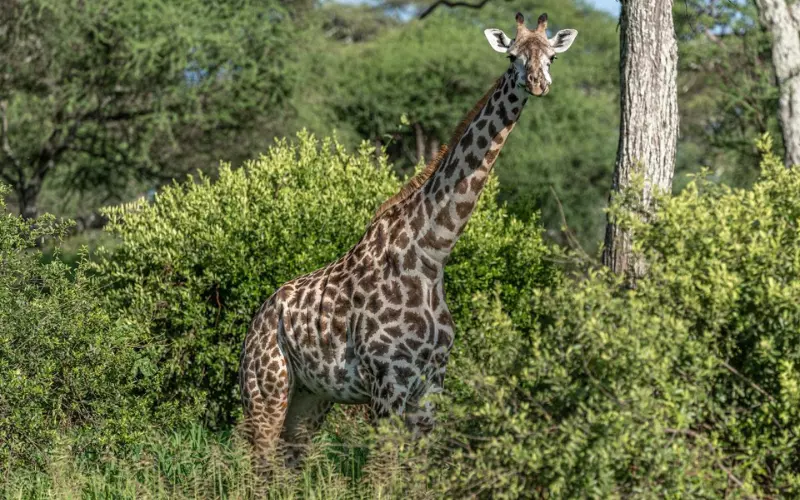
Giraffes have an enjoyable social life. They live in groups called herds, which can vary in size. These herds often consist of females, their young ones, and a few male giraffes. The females stay together and take care of their babies. They communicate with each other through sounds and body language. Giraffes are friendly creatures, often engaging in activities like grooming each other. This helps them build strong bonds and establish trust within the herd.
Regarding sexual behaviour, male giraffes establish dominance by fighting with each other. They use their long necks and muscular bodies to engage in fighting battles. This kind of behaviour helps them determine the strongest giraffe in the herd. Once the dominant male is established, he can mate with the females in the herd. During mating, the male mounts the female from behind and can be heard making loud grunting sounds.
Overall, giraffes have a unique social life. They stay together in herds and take care of each other. As for their sexual behaviour, the males fight to be the dominant one and get the chance to mate. Giraffes are truly fascinating creatures with their way of living and interacting with one another.
Reproduction and Lifecycle of Giraffe’s
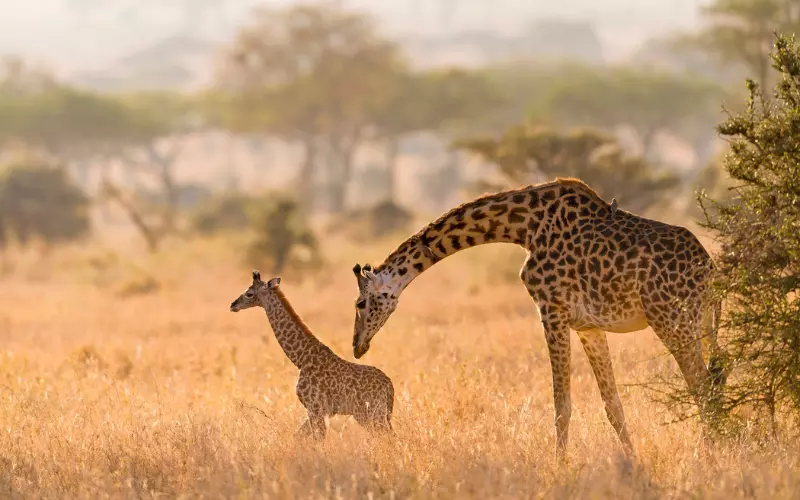
Giraffes, the tallest animals on Earth, have a fascinating reproduction and life cycle. Female giraffes, called cows, reach maturity at about 4 to 5 years old, while males, called bulls, mature a bit later. When it is time for mating, bulls fight over females by swinging their heads and necks at each other. The winner earns the right to mate with the female.
After mating, a female giraffe carries her baby for about 15 months. Finally, she gives birth to a single calf. This particular moment usually occurs while the giraffe is standing upright! The newborn calf falls more than 5 feet to the ground but quickly stands up within an hour of being born. The mother keeps her calf hidden in the first few days, away from threats like lions and hyenas. During this time, the mother giraffe feeds her little one with high nutrient-rich milk, helping the calf grow strong.
For the next year or so, the calf remains with its mother. It learns various skills like how to find food, protect itself, and communicate with other giraffes. Around age 2, the young giraffe becomes independent and ventures off to find its own territory. By age 7, giraffes are fully grown and ready to have their own babies. And so, the circle of life continues with the reproduction and life cycle of giraffes, who have adapted well to their unique environment.
Giraffes have an interesting reproduction and life cycle. After a fierce mating ritual, the female giraffe carries her baby for 15 months and then gives birth. The calf stands up quickly and stays close to its mother for about a year, learning essential skills. When it’s older, the giraffe becomes independent and starts its journey to adulthood. Giraffes have a long life expectancy of about 25 years in the wild and can live up to 40 years in captivity.
Threats to Giraffes
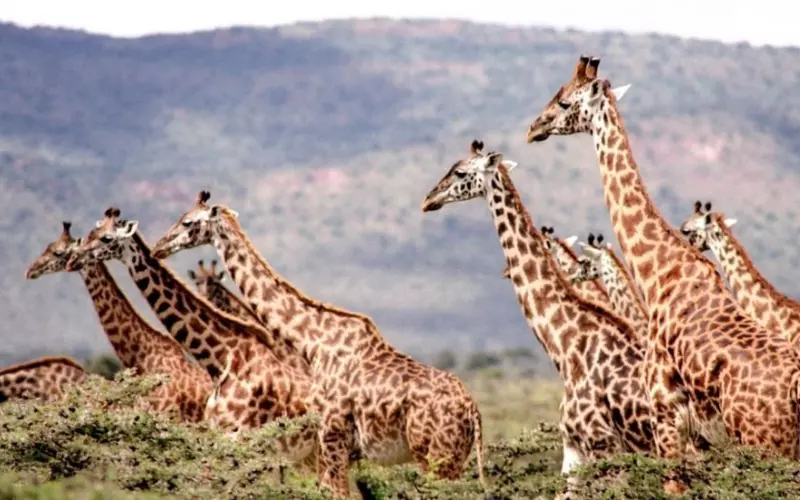
Giraffes face several threats that put them in danger. One significant threat is habitat loss. As the human population keeps growing, more and more land is being used for farming, building houses, and constructing roads. This reduces the space available for giraffes to live and find food. If they don’t have enough space and trees to eat from, giraffes can become weak and may even starve.
Another threat to giraffes is poaching. Some people hunt giraffes for their skins, meat, and other body parts. This is illegal in many places, but unfortunately, it still happens. Poaching can significantly reduce the number of wild giraffes and even make them extinct. It’s important for authorities to enforce laws against poaching and for all of us to say no to buying or using products made from giraffes.
Lastly, climate change is also becoming a threat to giraffes. The rise in global temperatures can affect the places where giraffes live. For example, some areas may become too hot for them or may not receive enough rainfall, causing the trees they feed on to die. Climate change can also make it easier for diseases to spread among giraffes. To protect giraffes from this threat, we need to take action to slow down climate change, like reducing our carbon emissions and using renewable energy sources.
Giraffes face threats such as habitat loss, poaching, and climate change that put their survival at risk. We must take steps to protect these magnificent animals and their habitats, such as supporting conservation efforts, spreading awareness, and making sustainable choices in our daily lives. We all have a role in ensuring a bright future for giraffes and the many other species we share this planet with.
Conclusion
Giraffes have a fascinating history and many interesting facts. These mighty animals are the tallest land mammals in the world. They have a long neck, long legs, and distinctive spotted coat. The animal’s Name, the giraffe, has captured people’s curiosity for centuries.
Giraffes are found in the savannahs of Africa. They prefer open grasslands where they can feed on leaves and buds from tall trees. These magnificent creatures have adapted to their habitat by having long necks that help them reach the leaves high up in the trees. Their size can vary, with males being taller than females and reaching 18 feet. Despite their height, giraffes have only seven neck vertebrae – just like humans!
Regarding classification, giraffes belong to the animal kingdom, the phylum Chordata, and the class Mammalia. They are part of the giraffidae family and the genus giraffa. With their distinctive appearance and gentle nature, giraffes are loved and admired by people worldwide. Learning about Animals Name the giraffe, can inspire us to appreciate and protect our planet’s incredible diversity of wildlife.
FAQ’s
What is the average height of a giraffe?
The average height of a giraffe is about 16-20 feet.
Why do giraffes have long necks?
Giraffes have long necks to reach leaves higher up in trees for their primary food source.
How heavy can a giraffe be?
Giraffes can weigh anywhere between 1,600 to 3,000 pounds.
Are giraffes social animals?
Yes, giraffes are social animals and typically live in herds.
What do giraffes eat?
Giraffes primarily eat leaves, twigs, and fruits from acacia trees.
How fast can a giraffe run?
Giraffes can run up to speeds of 35 miles per hour.
Do giraffes have any natural predators?
Yes, lions, hyenas, and crocodiles are some of the main predators of giraffes.
How do giraffes defend themselves against predators?
Giraffes use their strong legs and powerful kicks to defend against predators.
How long do giraffes typically live?
In the wild, giraffes have an average lifespan of 20 to 25 years, while those in captivity can live up to 30 years.
Do giraffes make any sounds?
Yes, giraffes can make sounds, including snorts, moans, hisses, and flute-like noises.
How many subspecies of giraffes are there?
Currently, there are nine recognized subspecies of giraffes.
Are giraffes endangered?
Yes, giraffes are considered vulnerable due to habitat loss and illegal hunting.
How long is a giraffe’s tongue?
A giraffe’s tongue can be around 18 to 20 inches long.
Do giraffes sleep standing up?
Yes, giraffes sleep standing up and only require about 30 minutes to two hours of sleep per day.
Can giraffes swim?
No, giraffes are not known to be natural swimmers due to their long limbs and lack of buoyancy.

Hi there! I’m Morgan Gutierrez, and I love animals! I work as a Seasonal Animal Care Specialist at Brookfield Zoo and also teach people about animals, which is super fun. I studied at Valparaiso University in Lockport, Illinois, where I learned even more about these amazing creatures.
I’m not just about taking care of animals; I write articles about them, too! I explore and share many interesting animal stories, from cute kittens to giant elephants.
In the past, I’ve worked with veterinarians, helped with research, and even been an Animal Ambassador, bringing animals closer to people. Animals are my passion, and I enjoy helping others learn about them. So, if you ever want to know about animals, feel free to ask. I’ll explain it in a way that’s easy to understand, just like talking to a friend!












